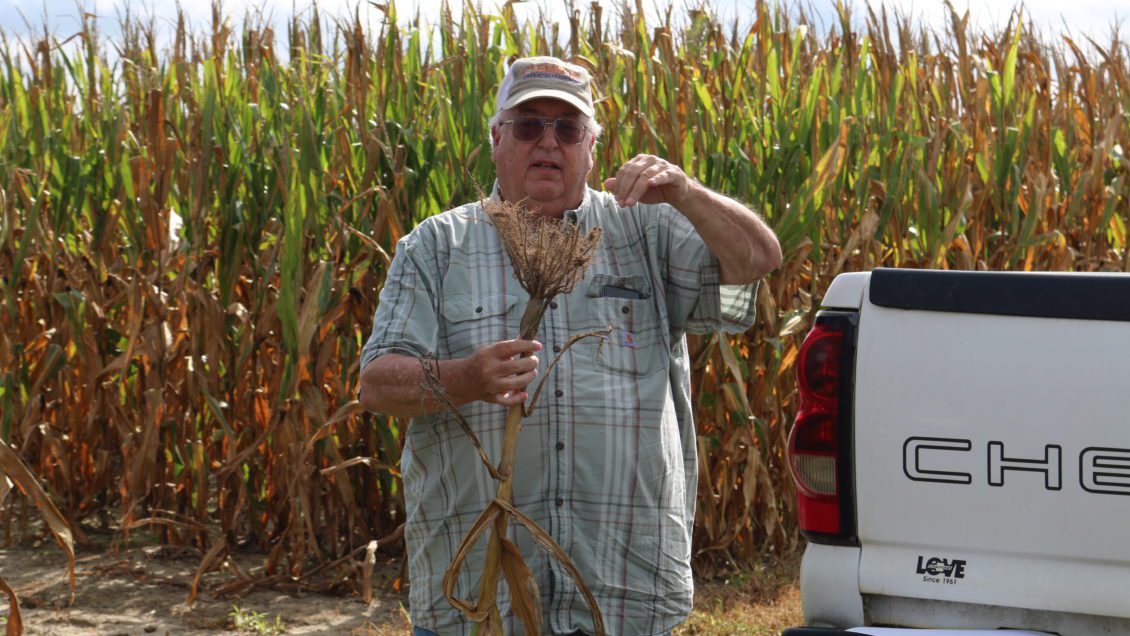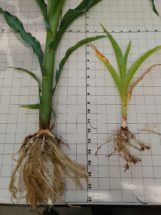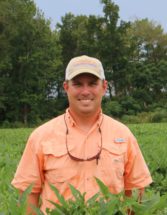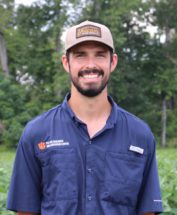
March 2022 was one of the warmest on record in South Carolina, leading to early corn planting dates that may have led to higher nematode activity and subsequent damage to plant roots.
This can mean lower yields for corn growers, but Clemson Cooperative Extension Service researchers say don’t give up.
During the 2022 Clemson Extension Corn Field Day at the Edisto Research and Education Center (REC) in Blackville, South Carolina, John Mueller, Clemson Extension row crop pathologist, told attendees higher early-season soil temperatures are leading to earlier nematode activity and greater damage to young corn roots.
Nematodes are non-segmented worms typically 1/500 of an inch in diameter and 1/20 of an inch in length. At least nine species of plant-parasitic nematodes frequently are recovered from South Carolina corn fields. The most common species are Columbia lance nematode, lesion nematodes, Southern root-knot nematode, sting nematode and stubby root nematode. Other species also can feed on corn roots, but the damage threshold required to cause yield losses is so high, these other nematode species normally are of little concern.

“Damage resulting from early season infections can lead to yield losses,” Mueller said. “These yield losses are most severe in the coarse sands of the Coastal plain. Fields with histories of 3 or more years of continuous corn have a high probability of having a nematode problem.”
Symptoms of possible nematode damage include areas of corn fields that are a lighter green than the rest of the field, or areas where plants are noticeably stunted. Higher sand content also can create these symptoms. To determine if nematodes are part of the problem, Mueller advises growers to dig up the roots and compare the roots of healthy plants to roots of damaged plants. Roots of nematode-infected corn plants may exhibit small galls. More commonly, infected roots have very stubby side roots which are typically swollen.
Roots also may have stubby, swollen roots clustered at the end of a root. This is referred to as the “bottle brush” effect. Plants growing in “poor,” typically sandy soils are already stressed and damage from nematodes exacerbates the damage. It takes fewer nematodes to cause noticeable damage in poor soils versus more productive soil textures.
Harvest is a good time to pull soil samples to check for nematodes. Pull samples from within 3 to 4 inches of the stalk. When taking samples, the probe should cut through roots at about 6 to 8 inches deep. A sample can represent a relatively small area where above ground symptoms were visible, or a larger area of a field. Samples should consist of at least four or five cores for the “bad area.” Samples representing a field should represent no more than 10 to 20 acres and should contain at least 10 cores. If fields have noticeable areas of differing soil textures or drainage patterns, Muller said these areas should be delineated and sampled separately.
Work with the local county agent to submit samples to the Clemson University Nematode Assay Laboratory.

March 2022 was the 22nd warmest March on record in South Carolina since 1895. The state’s average temperature for March 2022 was 57.7 degrees, 3.6 degrees warmer than the long-term average of 54.1 degrees. Most nematode species are most active and cause the most damage to plant roots in moderate soil temperature and moisture conditions. Stubby root nematodes tend to become active at temperatures 3 to 5 degrees lower than the other species.
Melissa Griffin, assistant state climatologist with the South Carolina Department of Natural Resources Climatology Office, said air temperature directly affects soil temperature because the sun heats air that comes in direct contact with the ground. Soil temperature is a measurement of the warmth of soil and is a factor for the germination, blooming and timing seeding of plants.
“Soil composition impacts heat capacity, which is the ability of the soil to store heat,” Griffin said. “Different types of soil heat and cool faster, meaning temperatures of these soil layers can fluctuate quickly.”
Clemson doctoral student studies corn and soybean double crop system

A Clemson doctoral student is researching to determine if double cropping corn and soybean can be profitable in South Carolina.
Bennett Harrelson is studying under Michael Plumblee, Clemson Extension corn and soybean specialist housed at the Edisto REC. Harrelson is studying several different agronomic factors revolving around the double crop corn and soybean production system including planting and harvest dates, row spacing and the use of at-plant nitrogen. The researchers also are studying to determine if this double-cropping system leads to issues with plant parasitic nematodes building up under certain scenarios.

“The idea of double cropping is not new and double cropping corn and soybean has been going on in Georgia for several years,” Plumblee said. “We wanted to evaluate the system in South Carolina with our climate and with our production practices. Last year, we estimated that about 10,000 acres of soybeans were planted behind corn. With continued interest in this production practice, we aim to determine a few best management practices for farmers who wish to implement this on their farms as well as to determine the economics of doing so.”
The project is geared toward generating applied research data that directly and immediately will help South Carolina growers. This research is funded by the South Carolina Soybean Board.
“If we can determine how to successfully grow soybean and corn in the same fields within the same year, this will benefit farmers in that they will be able to grow two cash crops on the same land, while hopefully generating more profit,” Harrelson said.
More information about corn management can be found in Corn Production Guide and in the 2022 South Carolina Pest Management Handbook.
Controlling weeds and insects
Weeds and insects pose additional problems for growers. Michael Marshall, Clemson Extension weed scientist, recommends pre-emergence herbicide applications.

“These applications can help reduce early-season competition for nutrients,” Marshall said. “We need to keep the weeds under control so that the plants can grow and create a canopy.”
Canopies help reduce weed pressures.
Palmer amaranth, or pigweed, is one weed Marshall is studying very closely, testing preemergence and postemergence herbicide systems including Impact Z, Atrazine, Roundup PowerMAX, Resicore, Capreno, Dual Magnum, Realm Q, Acuron, Revulin and Halex GT. Resicore + Atrazine preemergence followed by Roundup PowerMAX + Atrazine postemergence showed the greatest amount of Palmar amaranth control with 100% control at April 27 and May 16, and 95% control at June 3 and June 15.
Details about these corn herbicide products can be found in the Weed Control in Field corn chapter in the 2022 South Carolina Pest Management Handbook.

As for insect pests, Tim Bryant, assistant coordinator for the Clemson Extension Integrated Pest Management Program located at the Pee Dee REC, said the brown stink bug is a common insect of corn and has become a perennial pest because of some farm management practices.
“These practices include reduced and no tillage, as well as reduced use of broad-spectrum insecticides,” Bryant said. “Field corn is particularly susceptible to injury from brown stink bug, which can occur throughout much of the growing season.”
Brown stink bugs overwinter as adults in crop residues, leaves, weeds, and crevices in trees. They produce two to three generations per year and generally are active from April through October.
Corn is susceptible to injury at several stages throughout its development. From emergence through around the six-leaf stage, stink bugs feed directly on the growth point of developing plants and can cause stunting, tillering, and plant death in severe cases. Early injury from stink bug feeding ultimately can result in yield loss.
-END-
USDA-NASS South Carolina corn notes – The USDA National Agricultural Statistics Service 2021 State Agriculture Review for South Carolina reports state growers harvested 380,000 acres of grain corn for a production value of $311,638,000.
Get in touch and we will connect you with the author or another expert.
Or email us at news@clemson.edu
